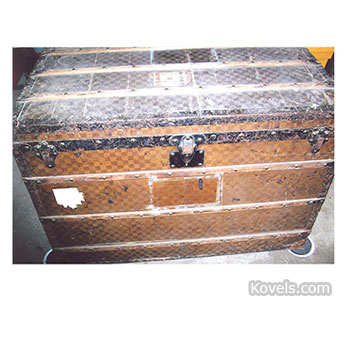Q: This Louis Vuitton canvas-covered trunk has been in my family for as long as I can remember. No family members remain who would know how we got it. It may have belonged to my grandfather, who emigrated from Germany in the early 1900s. The trunk is 39 1/2 inches wide, 23 1/2 inches deep, and 27 1/2 inches high and has four removable shelves inside. The label on the top is very worn but says, "Cie Gie Transatlantique" and "Paris, Le Havre, New York." Another label says, "Paris 1, Rue Scribe, Louis Vuitton, 149 New Bond Street, W., London." Can you give me any information about the trunk?
A: Antique Louis Vuitton trunks are very collectible, and some sell for thousands of dollars. In 1837, Louis Vuitton (1821-1892) moved from rural Anchay, France, to Paris and became an apprentice to a box maker. In the early 1800s, travelers didn't use suitcases or trunks. Box makers built boxes for wealthy travelers and even helped them pack. In 1854 Vuitton opened his own shop. He began making waterproof trunks and was one of the first to make flat-top trunks. Instead of leather, he used canvas treated with glue. Louis Vuitton's son opened a store in London in 1885. The store moved to 149 Bond Street in 1889. So your trunk was purchased after that. Another clue to its age is the checkerboard pattern on the canvas—it's a trademarked Vuitton pattern the company called "Damier Canvas." Your trunk is not in good condition, but the labels add interest. Trunks like yours usually sell for over $4,000. You should contact an auction house if you are interested in selling it.
The color of Louis Vuitton trunks helps determine the age.
- 1854 – gray "Trianon," a patented color
- 1872 – red and beige stripes
- 1876 – light and dark beige stripes
- 1888 – "Damier Canvas," a checkerboard pattern of beige and dark squares, with "Marque L. Vuitton deposee" printed in one square
- 1896 – Monogram pattern, with the initials "LV," flowers, and quatrefoils
The Compagnie Generale Transatlantique was a shipping company established in 1861. The route from Le Havre to New York began in 1886. The owner of this trunk must have sailed from France to New York in the 1890s or early 1900s.




Leave a Reply
You must be logged in to post a comment.